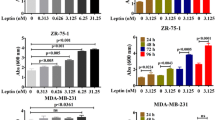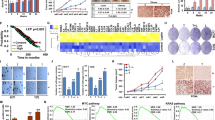Abstract
Leptin is a potent adipokine that plays an important role in the progression of breast cancer and interferes with the action of tamoxifen. We investigated the molecular mechanism underlying the effect of leptin on tamoxifen resistance in breast cancer cells that express leptin receptor (ObRb), and evaluated the impact of ObRb suppression on tamoxifen treatment in MCF-7 and tamoxifen-resistant (TAM-R) cells. Leptin-induced signaling pathway activation was examined by qRT-PCR and Western blotting. Chromatin immunoprecipitation assays were performed to further examine the binding of estrogen receptor (ER) α on the promoter of cyclin D1 (CCND1) gene. The effects of combined ObRb knockdown and tamoxifen treatment were evaluated in MCF-7 and TAM-R cells. We found that the enhanced proliferation effects induced by leptin were related to extracellular-signal-regulated kinase (ERK) 1/2 and signal transducers and activators of transcription (STAT) 3 signaling pathway activation and CCND1 upregulation. Leptin enhanced CCND1 gene transcription by inducing the binding of ERα to the promoter of CCND1 gene. ObRb knockdown significantly enhanced the inhibitory effects of tamoxifen on TAM-R cell proliferation and survival. This study suggested that long-term endocrine therapy facilitates leptin and ObRb overexpression in breast cancer cells, which attenuates the inhibitory effect of tamoxifen by activating both the ERK1/2 and STAT3 signaling pathways and upregulating CCND1 gene expression. Combination therapy involving ObRb knockdown and tamoxifen treatment may be an alternative therapeutic option for tamoxifen-resistant breast cancer.





Similar content being viewed by others
References
Siegel R, Naishadham D, Jemal A. Cancer statistics, 2012. Cancer J Clin. 2012;62(1):10–29. doi:10.3322/caac.20138.
Hurvitz SA, Pietras RJ. Rational management of endocrine resistance in breast cancer: a comprehensive review of estrogen receptor biology, treatment options, and future directions. Cancer. 2008;113(9):2385–97. doi:10.1002/cncr.23875.
Briest S, Stearns V. Tamoxifen metabolism and its effect on endocrine treatment of breast cancer. Clin Adv Hematol Oncol. 2009;7(3):185–92.
Lonning PE. Adjuvant endocrine treatment of early breast cancer. Hematol Oncol Clin North Am. 2007;21(2):223–38. doi:10.1016/j.hoc.2007.03.002.
Delozier T, Spielmann M, Mace-Lesec’h J, Janvier M, Hill C, Asselain B, et al. Tamoxifen adjuvant treatment duration in early breast cancer: initial results of a randomized study comparing short-term treatment with long-term treatment. Federation Nationale des Centres de Lutte Contre le Cancer Breast Group. J Clin Oncol. 2000;18(20):3507–12.
van Agthoven T, Sieuwerts AM, Meijer-van Gelder ME, Look MP, Smid M, Veldscholte J, et al. Relevance of breast cancer antiestrogen resistance genes in human breast cancer progression and tamoxifen resistance. J Clin Oncol. 2009;27(4):542–9. doi:10.1200/JCO.2008.17.1462.
Huang L, Li C. Leptin: a multifunctional hormone. Cell Res. 2000;10(2):81–92. doi:10.1038/sj.cr.7290038.
Rose DP, Komninou D, Stephenson GD. Obesity, adipocytokines, and insulin resistance in breast cancer. Obes Rev. 2004;5(3):153–65. doi:10.1111/j.1467-789X.2004.00142.x.
Zabeau L, Lavens D, Peelman F, Eyckerman S, Vandekerckhove J, Tavernier J. The ins and outs of leptin receptor activation. FEBS Lett. 2003;546(1):45–50.
Bjorbaek C, Uotani S, da Silva B, Flier JS. Divergent signaling capacities of the long and short isoforms of the leptin receptor. J Biol Chem. 1997;272(51):32686–95.
Garofalo C, Koda M, Cascio S, Sulkowska M, Kanczuga-Koda L, Golaszewska J, et al. Increased expression of leptin and the leptin receptor as a marker of breast cancer progression: possible role of obesity-related stimuli. Clin Cancer Res. 2006;12(5):1447–53. doi:10.1158/1078-0432.CCR-05-1913.
Ishikawa M, Kitayama J, Nagawa H. Enhanced expression of leptin and leptin receptor (OB-R) in human breast cancer. Clin Cancer Res. 2004;10(13):4325–31. doi:10.1158/1078-0432.CCR-03-0749.
Dubois V, Jarde T, Delort L, Billard H, Bernard-Gallon D, Berger E, et al. Leptin induces a proliferative response in breast cancer cells but not in normal breast cells. Nutr Cancer. 2014;66(4):645–55. doi:10.1080/01635581.2014.894104.
Chen X, Zha X, Chen W, Zhu T, Qiu J, Roe OD, et al. Leptin attenuates the anti-estrogen effect of tamoxifen in breast cancer. Biomed Pharmacother. 2013;67(1):22–30. doi:10.1016/j.biopha.2012.10.001.
Yuan HJ, Sun KW, Yu K. Leptin promotes the proliferation and migration of human breast cancer through the extracellular-signal regulated kinase pathway. Mol Med Rep. 2014;9(1):350–4. doi:10.3892/mmr.2013.1786.
Yamashita T, Murakami T, Otani S, Kuwajima M, Shima K. Leptin receptor signal transduction: OBRa and OBRb of fa type. Biochem Biophys Res Commun. 1998;246(3):752–9. doi:10.1006/bbrc.1998.8689.
Massarweh S, Schiff R. Unraveling the mechanisms of endocrine resistance in breast cancer: new therapeutic opportunities. Clin Cancer Res. 2007;13(7):1950–4. doi:10.1158/1078-0432.CCR-06-2540.
Ando S, Catalano S. The multifactorial role of leptin in driving the breast cancer microenvironment. Nat Rev Endocrinol. 2012;8(5):263–75. doi:10.1038/nrendo.2011.184.
Yom CK, Lee KM, Han W, Kim SW, Kim HS, Moon BI, et al. Leptin as a potential target for estrogen receptor-positive breast cancer. J Breast Cancer. 2013;16(2):138–45. doi:10.4048/jbc.2013.16.2.138.
Bostner J, Ahnstrom Waltersson M, Fornander T, Skoog L, Nordenskjold B, Stal O. Amplification of CCND1 and PAK1 as predictors of recurrence and tamoxifen resistance in postmenopausal breast cancer. Oncogene. 2007;26(49):6997–7005. doi:10.1038/sj.onc.1210506.
Stendahl M, Kronblad A, Ryden L, Emdin S, Bengtsson NO, Landberg G. Cyclin D1 overexpression is a negative predictive factor for tamoxifen response in postmenopausal breast cancer patients. Br J Cancer. 2004;90(10):1942–8. doi:10.1038/sj.bjc.6601831.
Catalano S, Giordano C, Rizza P, Gu G, Barone I, Bonofiglio D, et al. Evidence that leptin through STAT and CREB signaling enhances cyclin D1 expression and promotes human endometrial cancer proliferation. J Cell Physiol. 2009;218(3):490–500. doi:10.1002/jcp.21622.
Michalides R, Hageman P, van Tinteren H, Houben L, Wientjens E, Klompmaker R, et al. A clinicopathological study on overexpression of cyclin D1 and of p53 in a series of 248 patients with operable breast cancer. Br J Cancer. 1996;73(6):728–34.
Fan P, Wang J, Santen RJ, Yue W. Long-term treatment with tamoxifen facilitates translocation of estrogen receptor alpha out of the nucleus and enhances its interaction with EGFR in MCF-7 breast cancer cells. Cancer Res. 2007;67(3):1352–60. doi:10.1158/0008-5472.CAN-06-1020.
Saxena NK, Vertino PM, Anania FA, Sharma D. Leptin-induced growth stimulation of breast cancer cells involves recruitment of histone acetyltransferases and mediator complex to CYCLIN D1 promoter via activation of Stat3. J Biol Chem. 2007;282(18):13316–25. doi:10.1074/jbc.M609798200.
Eeckhoute J, Carroll JS, Geistlinger TR, Torres-Arzayus MI, Brown M. A cell-type-specific transcriptional network required for estrogen regulation of cyclin D1 and cell cycle progression in breast cancer. Genes Dev. 2006;20(18):2513–26. doi:10.1101/gad.1446006.
Binai NA, Damert A, Carra G, Steckelbroeck S, Lower J, Lower R, et al. Expression of estrogen receptor alpha increases leptin-induced STAT3 activity in breast cancer cells. Int J Cancer. 2010;127(1):55–66. doi:10.1002/ijc.25010.
Catalano S, Marsico S, Giordano C, Mauro L, Rizza P, Panno ML, et al. Leptin enhances, via AP-1, expression of aromatase in the MCF-7 cell line. J Biol Chem. 2003;278(31):28668–76. doi:10.1074/jbc.M301695200.
Hui R, Finney GL, Carroll JS, Lee CS, Musgrove EA, Sutherland RL. Constitutive overexpression of cyclin D1 but not cyclin E confers acute resistance to antiestrogens in T-47D breast cancer cells. Cancer Res. 2002;62(23):6916–23.
Miyoshi Y, Funahashi T, Tanaka S, Taguchi T, Tamaki Y, Shimomura I, et al. High expression of leptin receptor mRNA in breast cancer tissue predicts poor prognosis for patients with high, but not low, serum leptin levels. Int J Cancer. 2006;118(6):1414–9. doi:10.1002/ijc.21543.
Fusco R, Galgani M, Procaccini C, Franco R, Pirozzi G, Fucci L, et al. Cellular and molecular crosstalk between leptin receptor and estrogen receptor-{alpha} in breast cancer: molecular basis for a novel therapeutic setting. Endocr Relat Cancer. 2010;17(2):373–82. doi:10.1677/ERC-09-0340.
Acknowledgments
This work was supported by the National Natural Science Foundation of China (grant numbers 81301896, 81172503).
Conflict of interest
None.
Author information
Authors and Affiliations
Corresponding authors
Additional information
Yingying Qian and Dongmin Shi contributed equally to this work.
Electronic supplementary material
Below is the link to the electronic supplementary material.
Online Resource 1
(PDF 591 kb)
Online Resource 2
(PDF 511 kb)
Rights and permissions
About this article
Cite this article
Qian, Y., Shi, D., Qiu, J. et al. ObRb downregulation increases breast cancer cell sensitivity to tamoxifen. Tumor Biol. 36, 6813–6821 (2015). https://doi.org/10.1007/s13277-015-3375-5
Received:
Accepted:
Published:
Issue Date:
DOI: https://doi.org/10.1007/s13277-015-3375-5




